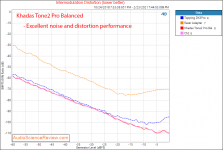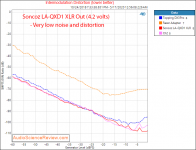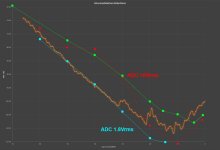Cosmos DAC has dual-mono 9038Q2M, and I am not limited by the PCB 45x20mm and 86mA idle current there. My needs are easy to see, my goal as for everyone else on this forum - good inexpensive replacement for the archaic AP dower chest. I have no predict good money on that ADC project, not too many people want to measure their audio equipment, unlike USB dongle DACs like 9038D with DR 125db(A) and THD+N -118db for the same $100.
BTW, this one is another 9038Q2M(single) based DAC, IMD -110db, however, DR is about 3db worse vs 9038D, and THD+N of course a bit higher. Better implementation for sure will improve IMD more. And one more example with even worse THD+N but IMD still close to -110db.
BTW, this one is another 9038Q2M(single) based DAC, IMD -110db, however, DR is about 3db worse vs 9038D, and THD+N of course a bit higher. Better implementation for sure will improve IMD more. And one more example with even worse THD+N but IMD still close to -110db.
Attachments
Last edited:
I did remeasure IMD as mentioned with AP digital analyzer, the dest reading I've seen was -107.5db SMPTE 4:1 80/2000 at -4dbfs. Seems ARTA as many other FFT apps aren't worth trusting. I like the approach of REW developer(John as I remember) yet after I said him that REW calculating THD+N was wrong he did find the solution the same day and fixed that. Actually, I hate REW doesn't support WASAPI only ASIO or ASIO4ALL, after using that my ADC volume slider stopping to work. I have to reinstall the Comtrue driver to get the slider to work again! Seems ASIO4ALL occupating the volume control and Windows can not change the volume until the ADC is completely deleted with its driver.
I can try to realize how big is the contribution of ADC to the total IMD if I'll use 80Hz from the left channel, and 2000Hz from the right channel and mix it on the ADC input impedance. I guess the DAC has IMD better for 3-6db i.e. -110-115db, obviously with no hump.
I can try to realize how big is the contribution of ADC to the total IMD if I'll use 80Hz from the left channel, and 2000Hz from the right channel and mix it on the ADC input impedance. I guess the DAC has IMD better for 3-6db i.e. -110-115db, obviously with no hump.
Attachments
Last edited:
Actually, I hate REW doesn't support WASAPI only ASIO or ASIO4ALL, after using that my ADC volume slider stopping to work.
If comtrue is a proper UAC2 device, you can measure with REW in linux bitperfectly, without any worries about opaque asio-wasapi bridges. Since you want to base your product on the comtrue chip, it should be tested in linux anyway.
If comtrue is a proper UAC2 device, you can measure with REW in linux bitperfectly, without any worries about opaque asio-wasapi bridges. Since you want to base your product on the comtrue chip, it should be tested in linux anyway.
Comtrue works fine with iOS, Mac OS, Linux, Android. Usually, more complaints coming from Windows users. I've prepared 4 samples of Cosmos ADC to send for review and testing. Goldensound, Archimago etc.
Well then nothing prevents you from using REW in e.g. Ubuntu and avoid all the hassles with windows java not having any simple support for bit-perfect wasapi-exclusive (yet).
As of "works fine" - have you or others confirmed that the comtrue async feedback is working properly in linux (as well as in windows)?
REW works but as I said, I used ASIO4ALL to run 2 devices, and after that Windows volume slider stopped work. I need that slider to select ADC 1/2ch mode(Volume slide < 50% = 2ch, > 50% 1ch).
in my FW the FB option is not in use. I tried that with Windows 10, it works but is less stable than without FB. I didn't notice any specs improvement if FB is On as well.
FB is for playback (your DAC project). If you use adaptive USB (i.e. no async feedback), then you must use ASRC in ESS (no sync 128xFs), otherwise glitches will inevitably appear.
The ES DACs in ASRC, or 128xFS?
No FB means adaptive mode, the transport is clocked by the USB host clock. Either the output clock from the comtrue is PLLed (standard adaptive), or there is a fifo in the chip separating the USB and master clock domains which will eventually over/underflow.
No FB means adaptive mode, the transport is clocked by the USB host clock. Either the output clock from the comtrue is PLLed (standard adaptive), or there is a fifo in the chip separating the USB and master clock domains which will eventually over/underflow.
I did remeasure IMD as mentioned with AP digital analyzer, the dest reading I've seen was -107.5db SMPTE 4:1 80/2000 at -4dbfs. Seems ARTA as many other FFT apps aren't worth trusting. I like the approach of REW developer(John as I remember) yet after I said him that REW calculating THD+N was wrong he did find the solution the same day and fixed that. Actually, I hate REW doesn't support WASAPI only ASIO or ASIO4ALL, after using that my ADC volume slider stopping to work. I have to reinstall the Comtrue driver to get the slider to work again! Seems ASIO4ALL occupating the volume control and Windows can not change the volume until the ADC is completely deleted with its driver.
I can try to realize how big is the contribution of ADC to the total IMD if I'll use 80Hz from the left channel, and 2000Hz from the right channel and mix it on the ADC input impedance. I guess the DAC has IMD better for 3-6db i.e. -110-115db, obviously with no hump.
Now, the green trace makes some sense for an ES9038Q2M 😀. The ES9038PRO is likely around -117dB, unfortunately the Rohde doesn't go that low on the analog input (is specified at -110dB residual) only the APx555 goes that low. I'll see what I get when I'll finish the ES9822PRO board.
The ES DACs in ASRC, or 128xFS?
No FB means adaptive mode, the transport is clocked by the USB host clock. Either the output clock from the comtrue is PLLed (standard adaptive), or there is a fifo in the chip separating the USB and master clock domains which will eventually over/underflow.
ESS dacs have an internal ASRC which by default is always used whether it is needed or not. Therefore ESS claims their dac chips only need one reasonably good clock to play all sample rates. However the ASRC can be turned off by I2C control, and the dac chip can be configured to operate in synchronous mode with two local audio clocks.
Regarding asynchronous USB, that often is used even if an ESS dac is running from a single clock with ASRC enabled. In that case the USB interface usually has its own clocks so it can run an async USB connection to the PC.
Last edited:
Markw4: for maximum performance for measurement purposes I would assume no ASRC, i.e. 128xFS, master clock by the DAC (clocking the USB receiver fifo readout too), and proper async mode (which requires working feedback). But it's perfectly possible the performance difference from adaptive mode with ESS ASRC is miniscule.
Last edited:
IVX

That's great!Some of Cosmos ADC samples shows THD-N 0.00002%@1kHz and THD+N 0.00007%

Very good numbers indeed!
What is the spread between the units?
I used my AP SYS2522 generator in that test which is not precise enough to find out unit2unit variations, anyhow, all 6 individually calibrated units show me at least .00003% at -.5dbfs level. ES9822 has LUT to correct its linearity, when I saying "individually calibrated" I mean LUTs coefficients adjustment(only 2nd, 3rd, and sometimes 5th harmonics I trying to compensate). Not calibrated ES9822 has up to 3 times worse THD.
Is the calibration frequency and level dependent?
A Look Inside the New ES9028PRO Converter Chip and the New DAC3 - Benchmark Media Systems
My opinion https://www.diyaudio.com/forums/equ...nsation-measurement-setup-42.html#post6760531
- Home
- Design & Build
- Equipment & Tools
- ADCs and DACs for audio instrumentation applications




